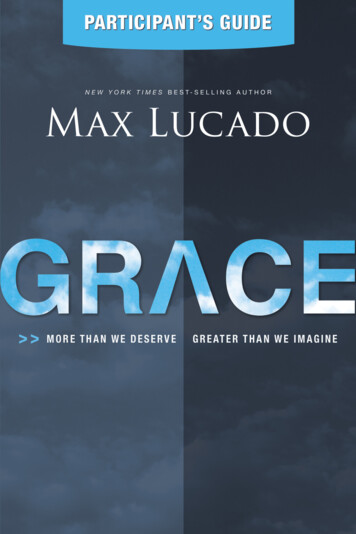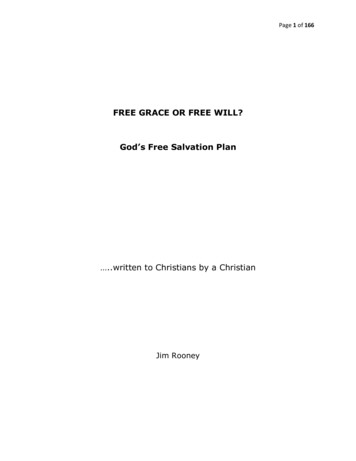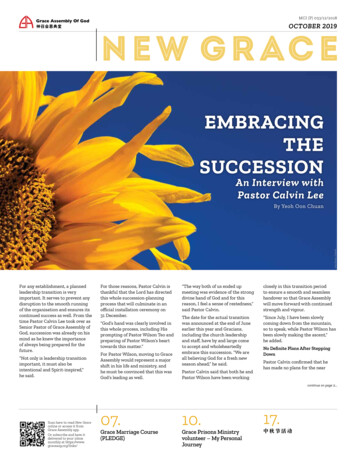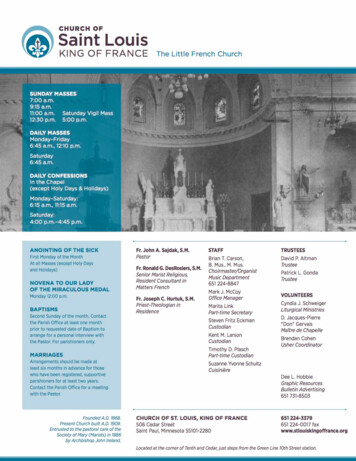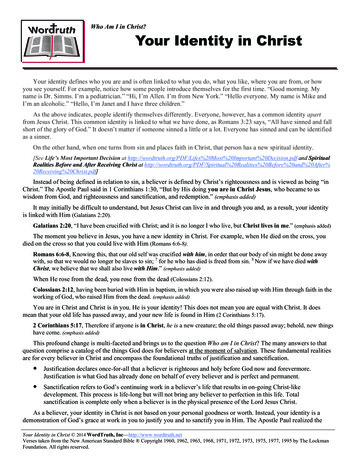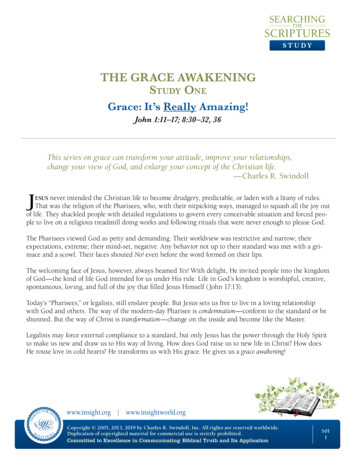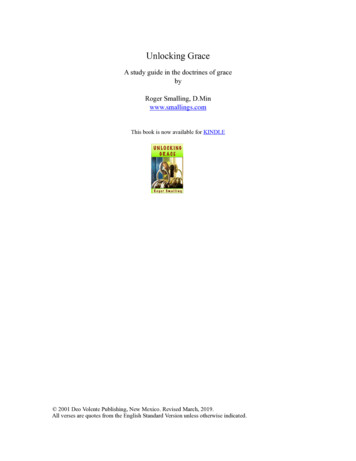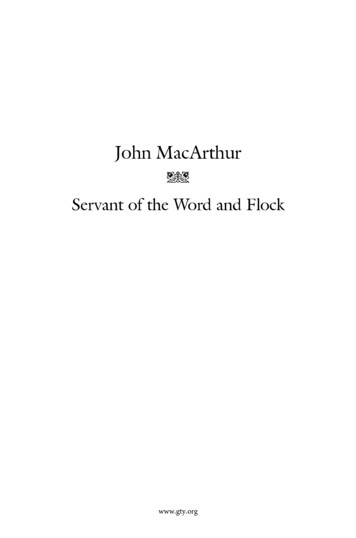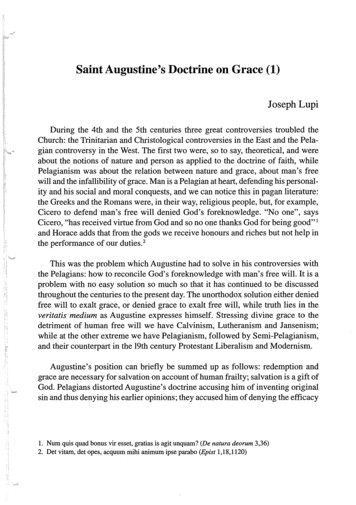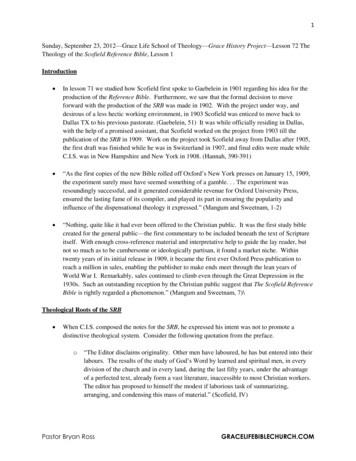
Transcription
1Sunday, September 23, 2012—Grace Life School of Theology—Grace History Project—Lesson 72 TheTheology of the Scofield Reference Bible, Lesson 1Introduction In lesson 71 we studied how Scofield first spoke to Gaebelein in 1901 regarding his idea for theproduction of the Reference Bible. Furthermore, we saw that the formal decision to moveforward with the production of the SRB was made in 1902. With the project under way, anddesirous of a less hectic working environment, in 1903 Scofield was enticed to move back toDallas TX to his previous pastorate. (Gaebelein, 51) It was while officially residing in Dallas,with the help of a promised assistant, that Scofield worked on the project from 1903 till thepublication of the SRB in 1909. Work on the project took Scofield away from Dallas after 1905,the first draft was finished while he was in Switzerland in 1907, and final edits were made whileC.I.S. was in New Hampshire and New York in 1908. (Hannah, 390-391) “As the first copies of the new Bible rolled off Oxford’s New York presses on January 15, 1909,the experiment surely must have seemed something of a gamble. . . The experiment wasresoundingly successful, and it generated considerable revenue for Oxford University Press,ensured the lasting fame of its compiler, and played its part in ensuring the popularity andinfluence of the dispensational theology it expressed.” (Mangum and Sweetnam, 1-2) “Nothing, quite like it had ever been offered to the Christian public. It was the first study biblecreated for the general public—the first commentary to be included beneath the text of Scriptureitself. With enough cross-reference material and interpretative help to guide the lay reader, butnot so much as to be cumbersome or ideologically partisan, it found a market niche. Withintwenty years of its initial release in 1909, it became the first ever Oxford Press publication toreach a million in sales, enabling the publisher to make ends meet through the lean years ofWorld War I. Remarkably, sales continued to climb even through the Great Depression in the1930s. Such an outstanding reception by the Christian public suggest that The Scofield ReferenceBible is rightly regarded a phenomenon.” (Mangum and Sweetnam, 7)\Theological Roots of the SRB When C.I.S. composed the notes for the SRB, he expressed his intent was not to promote adistinctive theological system. Consider the following quotation from the preface.o“The Editor disclaims originality. Other men have laboured, he has but entered into theirlabours. The results of the study of God’s Word by learned and spiritual men, in everydivision of the church and in every land, during the last fifty years, under the advantageof a perfected text, already form a vast literature, inaccessible to most Christian workers.The editor has proposed to himself the modest if laborious task of summarizing,arranging, and condensing this mass of material.” (Scofield, IV)Pastor Bryan RossGRACELIFEBIBLECHURCH.COM
2 That being said, a theological perspective could not have but come through. Readers of the SRBcan detect several streams of theological thought popular in Western Christianity in the early partof the last century within Scofield’s work. Our goal in this section is to survey what theseinfluences where. While there can be little doubt that Scofield’s treatment of dispensational theology attracts themost attention when considering the roots of the SRB, it is important to remember that much ofScofield’s commentary is a repackaging of teaching that can be traced to the evangelicalism ofthe post-Reformation era. Therefore, much of the commentary presented in the SRB would havebeen unremarkable to evangelical Christians in any period. (Mangum and Sweetnam, 54) The concept of an annotated Bible with commentary appearing alongside Scripture can clearly betraced back to one prototype: the Geneva Bible which first appeared in 1560. There had beennumerous attempts to package Scripture and commentary before the Geneva Bible, but in allthese cases, while extra material was included in the physical volume, it appeared as an appendix,not alongside the sacred text. (Mangum and Sweetnam, 55) “In addition to the commentary and cross-references he supplied in the first edition, the 1917revision of Scofield’s Bible assigned a date to every event recorded in Scripture. Scofieldintroduced this chronology at the prompting of his editor. Scofield’s use popularized thischronology, but he did not devise it. That honor goes to James Ussher who was a prominentPuritan bishop in the Irish church. Ussher ultimately reached the height of his eminence asarchbishop of Armagh. . . He was also appointed vice-chancellor and subsequently vice-provostof Trinity College Dublin. . . Ussher was a consistent voice for the continued reformation of theIrish Church, and the Irish Articles (1615) that he was largely responsible for drawing up were tobe enormously influential, eventually proving the basis for The Westminster Confession of Faith.”(Mangum and Sweetnam, 58) “His (Ussher’s) most extensive project was his attempt to write a history of the world fromcreation to contemporary times. This mammoth work was published in two parts: the first,Annales veteris testament, a prima mundi origine deducti (Annals of the Old Testament deducedfrom the first origins of the world) appeared in 1650; and its continuation Annalium parspostierior, followed in 1654. . . Many of his dates have been confirmed by modern research. Thescale of Ussher’s achievement, however, is often overlooked, and his Annals are rememberedonly for his dating creation at 4004 BC. (Mangum and Sweetnam, 59) “It is somewhat ironic, therefore, that the most successful popularization of Ussher’schronological conclusions—in the margins of the Scofield Reference Bible—differed with Ussheronly in the date assigned to creation. Faced with the apparently implacable demands ofgeological science and Darwin’s theory of evolution for an Earth far older than six thousandyears, Scofield retreated to the gap theory: a reading of the first chapter of Genesis that positedthe existence of an unknown but very considerable gap between the creation of the universe asrecorded in Genesis 1:1 and the supposed re-creation of a world devastated by some divinejudgment in Genesis 1:2.” (Mangum and Sweetnam, 59-60)Pastor Bryan RossGRACELIFEBIBLECHURCH.COM
3 That Scofield and his Bible was the product of a strong dispensational movement both in theUnited States and Europe has been well documented throughout the Grace History Project.Therefore, it is not necessary that we rehash again these details. Interested parties should consultpast lessons to learn the details of these connections. However, we do want to consider how otherfactors influenced the notes that appear in the SRB. Scofield’s conversion experience played a powerful role in shaping his theology. “First,Scofield’s understanding of grace was such that he envisioned its rendering null and void anydebt, guilt, or obligation on the part of the sinner. Grace, for Scofield, represented a completeabsolution from any blame. Furthermore, this gracious acquittal of Scofield’s view is afforded toan individual upon their placing personal faith in Jesus Christ.” (Mangum and Sweetnam, 74)o“The condition of the new birth is faith in Christ crucified. . . Through the new birth thebeliever becomes a partaker of the divine nature and of the life of Christ himself.”(Scofield, 1118) “Also worth noting is the background Scofield had in the legal profession before his conversion.Several assessments of Scofield’s theology, both positive and negative, observe this point.Scofield seems to have read the Bible with particular concern for what is practically applicable—or legally binding. His theological system, his dispensational template, is derived in part from hisdesire to discern clearly what a reader should take as directly obligatory (with penalties attachedfor failure and with benefits attached for compliance). This approach to the bible has much incommon with a lawyer’s approach to legal statutes. Likewise, the cross-referencing system thatScofield employed, with its correlation of key terms with past precedents, has much in commonwith a lawyer’s approach to judicial decisions.” (Mangum and Sweetnam, 75) Scofield designed his study Bible to be a tool for those needing or desiring to be self-taught in thecontent and meaning of the Bible. The inductive approach that emphasized first-thought, plainsense, and self-evident observation as the key to interpretation became the hallmark of the SRB. That C.I.S. was heavily influenced by his first spiritual mentor James H. Brookes is beyondcontention and has already been well established by the Grace History Project. In Brookes wesee an amalgamation of Southern Presbyterian Calvinism and dispensational premillennialism.Therefore, it should come as no surprise that a similar phenomenon is observable in the theologyarticulated by Scofield. Scofield seems to have derived his distinctive brand of dispensationalismfrom Bookes’ theology. Scofield expanded and simplified the Southern Presbyterian tenant of thespiritual nature of the church into an Israel-church divide, eternally permanent. Old TestamentIsrael’s role as God’s earthly people as opposed to the New Testament church’s role as God’sheavenly people would become a central point in Scofield’s dispensational theology. (Mangumand Sweetnam, 77) In contrast to JND’s doctrine of the ruin of the church, Brookes taught that, in a world gonehorribly wrong, the visible church represented a spiritual haven and oasis. For Brookes thePastor Bryan RossGRACELIFEBIBLECHURCH.COM
4church would stand as a countercultural testimony to the grace of God until Jesus came back torescue his people out of the world, which, outside of the church, he too believed would growprogressively worse until then. In addition, Scofield’s emphasis on God’s sovereignty, includingGod electing and predestining those who would become his, suggests a general Calvinisticinfluence. (Magnum and Sweetnam, 81-81) Scofield’s comments on Genesis 9 indicate a strong Southern influence. Scofield states thefollowing regarding the curse of Ham in his comments on Genesis 9:25.o“A prophetic declaration is made that from Ham will descend an inferior and servileposterity (Gen. 9:24-25).” (Scofield, 16) This point in the SRB would give stature and popularity to the theory of the curse of Ham—thatblack people are inferior to people of other races and destined to be their servants—throughoutbroad areas of the American fundamentalist-evangelical world . . .It was a common interpretationin the mid-nineteenth century South; its inclusion in the SRB played a major role in extending thepopularity of this suspect interpretation well into the twentieth century. (Mangum and Sweetnam,82-83) While Scofield did not seek to advance any specific denominational agenda through the SRB, hewas, however, clearly theologically conservative. “Several of his notes are devoted to defendingthe Bible’s historicity. In fact, his whole dispensational scheme appears to be designed in part toprovide a readily understandable means of preserving the unity of the Bible’s message, that is,protecting the bible from the charge of teaching contradictory principles. To this extent,Scofield’s work seems rooted in the background of the modernist-fundamentalist polarization ofthe late nineteenth and early twentieth centuries. . . Scofield advocated distinctly dispensationalistpositions, but he does not seem to have been aware of their distinctiveness; nor does he seem tohave anticipated these positions becoming controversial. Rather, Scofield seems to have regardedhis world as reflecting the consensus of a broad coalition of Bible-believing interpreters ofScripture. In this way, his work reflects the influence of the early American fundamentalistevangelical movement.” (Mangum and Sweetnam, 84-85) The influence of American premillennialism and the Niagara Bible Conference movement areclearly seen in the eschatology presented by Scofield in the SRB. “Scofield sees the divinepurpose of the tribulation period being to provide a means for God to pour out his wrath on thereprobate inhabitants of earth, meanwhile simultaneously isolating—thereby purging andreviving—ethnic, national Israel. The millennial period then serves as the period in which all theprophecies to Israel presently awaiting their realization are fulfilled, with Jesus the Messiah-Kingenthroned on David’s throne in Jerusalem. The level of eschatological detail in all this is itselfevidence of the significant influence of American premillennialism on Scofield’s thought.”(Mangum and Sweetnam, 89) In summary of this section, Scofield’s “law-grace division provided a means of interpreting theBible in a literal fashion, proving a unity of the Bible’s overall message. . .This literalism andPastor Bryan RossGRACELIFEBIBLECHURCH.COM
5emphasis on seeking direct, individual, personal applicability of New Testament teaching was aprominent feature of early American fundamentalism-evangelicalism. . . the distinction betweenlaw and grace underpinned the distinction between Israel and the church, which in turnunderwrote a chronology of future events that emphasized a place of special prominence fornational Israel during Christ’s earthly reign in the future millennium; all of this of course, foundsupport and precedent in the American premillennialist movement.” (Mangum and Sweetnam,91) The SRB therefore is an illustration of (and primary influence on) the development of twentiethcentury American Christianity. Until it became so popular as to become a lightning rod forcontroversy, the Scofield Reference Bible served first as a means of promoting consensus amongBible-believing American Christians. (Mangum and Sweetnam, 91)Consulting Editors on the SRB The title page of the SRB lists other men with whom Scofield supposedly consulted whenpreparing the notes. These editors were some of the most prominent fundamental andpremillennial leaders in the country. They included:ooooooooRev. Henry G. Weston, D.D., LL. D. (President Crozer Theological SeminaryRev. James M. Gray, D.D. (President Moody Bible Institute)Rev. William J. Erdman, D.D. (Author The Gospel of John)Rev. Arthur T. Pierson, D.D. (Author, Editor, Teacher)Rev. W.G. Moorehead, D.D. (President Xenia Theological Seminary)Rev. Elmore Harris, D.D. (President Toronto Bible Institute)Rev. Arno C. Gaebelein, D.D. (Author Harmony of Prophetic Word)Rev. William L. Pettingill, D.D. (Author, Editor, Teacher) As we saw in Lesson 70, W.G. Moorehead and William J. Erdman were part of the faction withinthe Niagara Bible Conference that denied the any-moment rapture position in favor ofposttribulation view as to the timing of the rapture. Furthermore, Moorehead and Erdman alongwith Cameron where vocal opponents of Scofield and Gray in December 1901 at the finalmeeting of Niagara’s leadership. Consequently, it is somewhat strange that the names ofMoorehead and Erdman are listed by Scofield as consulting editors on the title page of the SRB. Ernest R. Sandeen comments on this phenomenon in his book The Roots of Fundamentalism.Sandeen states:o“On the title page of the Scofield Reference Bible eight “consulting editors” were named(see above): . . . Just what role these consulting editors played in the project has been thesubject of some confusion. Apparently Scofield meant to acknowledge their assistance,though some have speculated that he hoped to gain support for his publication from bothsides of the millenarian movement with this device. At any rate it is clear that theScofield Reference Bible was uncompromisingly Darbyite dispensationalist in doctrinePastor Bryan RossGRACELIFEBIBLECHURCH.COM
6and taught the any-moment coming and secret rapture of the church. Although heconsulted posttribulationist scholars, their views about the time of the advent were notreflected in his work.” (Sandeen, 224) Even Gaebelein is fuzzy regarding how much contact and input Scofield received from the othereditors particularly Erdman and Moorehead. Gaebelein writes,o “The writer does not know how much correspondence Dr. Scofield carried on with theother consulting editors. More than once did he express his indebtedness to them. . . He(Scofield) told us, that he exchanged many letters with Dr. W.J. Erdman about the term“kingdom” and its use in the New Testament. Nor was there always a full agreement inthese consultations. We cannot follow in this sketch other interesting details of theseconsultations. What we have written are but illustration of the thoroughness with whichthe work was done.” (Gaebelein, 57, 59)There can be little doubt that of the eight consulting editors listed above, Gaebelein and Grayinfluenced the SRB project the most. James Martin Gray (1851-1935) was, for years, president ofMoody Bible Institute. In 1901, Gray published Dispensational Bible Studies in which hepresented the following dispensational outline.ooooooooEdenic AgeAntediluvian AgePatriarchal AgeMosaic AgeChurch AgeMillennial Age“Fulness of the Times” AgeEternal Age (Ehlert, 77) “It was in New York City working with the Jewish community that Gaebelein became apremillennialist (ca. 1887). He wrote: “this attempt to bring the Gospel to the Jews led me deeperinto the Old Testament Scriptures. I began to study prophecy. Up to this time I had followed inthe interpretation of Old Testament prophecy the so-called ‘spiritualization method’(allegorical).” He realized that only with literal interpretation would Israel mean Israel and notthe church. He realized that a promise of redemption back to the land of Palestine still held forthe Jews.” (Couch, 120) “Gaebelein realized that the differences in Bible interpretation were caused by a conflict inhermeneutics. He followed two basic rules for interpreting the Scriptures. He felt a literalgrammatical interpretation led to a national restoration for Israel’s future. And secondly, thisapproach led one to see the church as a new entity unrevealed in the Old Testament but clearlyoutlined in the book of Ephesians.” (Couch, 120)Pastor Bryan RossGRACELIFEBIBLECHURCH.COM
7 “Gaebelein also used a dispensational hermeneutic. He saw three major dispensations: law,grace, and kingdom. . . .He also felt strongly about the doctrine of the rapture of the church. Nosigns needed to herald Christ’s coming. The church clearly would not go through the GreatTribulation. The coming of Christ in the air to receive the church is a separate event from Hiscoming to the earth to set up His kingdom seven years later. Finally, three crucial doctrines werebehind Gaebelein’s dispensationalism: 1) the inerrancy of Scripture, 2) the premillennial comingof Christ, and 3) the pretribulational Rapture.” (Couch, 120) Gaebelein’s influence on the SRB is most clearly seen when it comes to the subject of Biblicalprophecy. In The History of the Scofield Reference Bible, Gaebelein states the following:o“Dr. Scofield was especially concerned about the sane and scriptural interpretation ofprophecy. The writer gave a series of addresses during the second Sea Cliff Conferenceon “The Harmony of the Prophetic Word.” After listening to these lectures, Dr. Scofieldsaid they expressed the method he intended to follow in the Reference bible, and he urgedthe writer to prepare material, with additional lectures, for publication in a volume. Hedeclared that such a volume would be most helpful to him in his Bible work.” (Gaebelein,53) Gaebelein states that between 1903 and 1909 he received written requests from Scofield for hisinput on: 1) dates of the minor prophets, 2) the prophetic interpretation of the books of Daniel andRevelation, 3) the parables, particularly the parable of the ten virgins, and 4) II Thessalonians 2.(Gaebelein, 58) “Some time later, Dr. Scofield requested the analysis of a number of the prophetic books and theinterpretation of difficult and disputed prophecies from the writer, and after our consent to do so,we received his reply:oMy beloved Brother—By all means, follow your own views of prophetic analysis. I sit atyour feet when it comes to prophecy, and congratulate in advance the future readers ofthe Reference Bible on having in their hands a safe, a clear, sane guide through what tomost is a labyrinth. Yours lovingly in Christ, C.I.S.” (Gaebelein, 55-56)Pastor Bryan RossGRACELIFEBIBLECHURCH.COM
8Works CitedCouch, Mal. “Arno Gaebelein.” in Dictionary of Premillennial Theology. Grand Rapids, MI: KregelPublications, 1996.Gaebelein, Arno, C. The History of the Scofield Reference Bible. New York, NY: Our Hope Publications,1943. t.html.Ehlert, Arnold D. A Bibliographic History of Dispensationalism. Grand Rapids, MI: Baker Book House,1965.Hannah, John. “Cyrus Ingerson Scofield” in Dictionary of Premillennial Theology. Grand Rapids, MI:Kregel Publications, 1996.Mangum, R. Todd, and Mark S. Sweetnam. The Scofield Bible: It’s History and Impact on theEvangelical Church. Colorado Springs, CO: Paternoster, 2009.Sandeen, Ernest R. The Roots of Fundamentalism: British & American Millenarianism, 1800-1930.Chicago, IL: The University of Chicago Press, 1970.Scofield, C.I. Scofield Reference Bible. New York, NY: Oxford University Press, 1909.Pastor Bryan RossGRACELIFEBIBLECHURCH.COM
Theology of the Scofield Reference Bible, Lesson 1 Introduction In lesson 71 we studied how Scofield first spoke to Gaebelein in 1901 regarding his idea for the production of the Reference Bible. Furthermore, we saw that the formal decision to move forward with the production of the SRB was made in 1902. With the project under way, and
